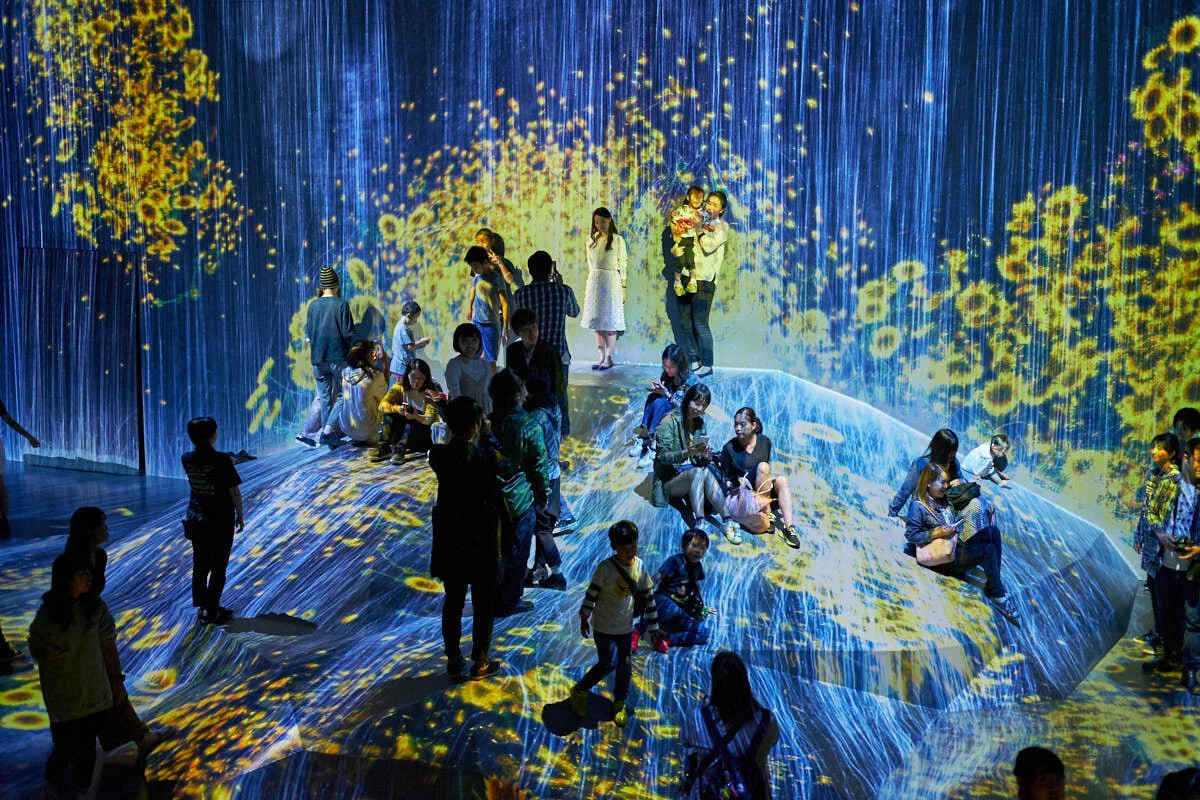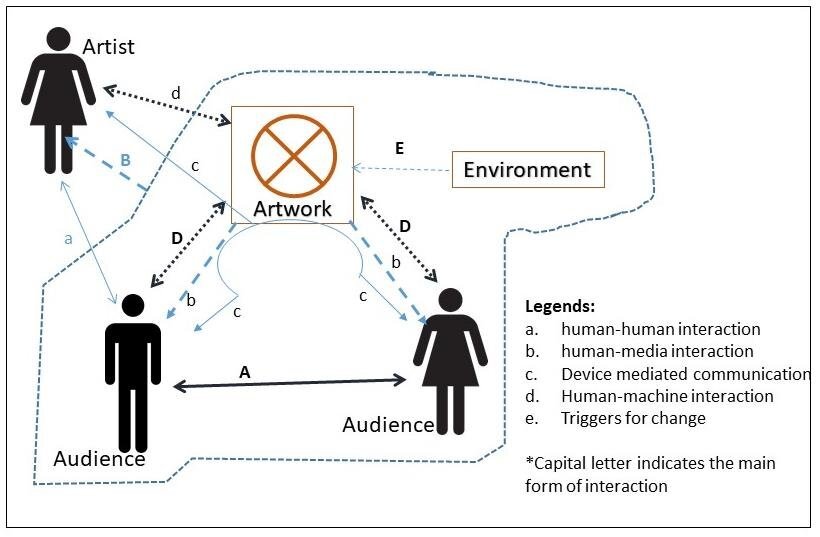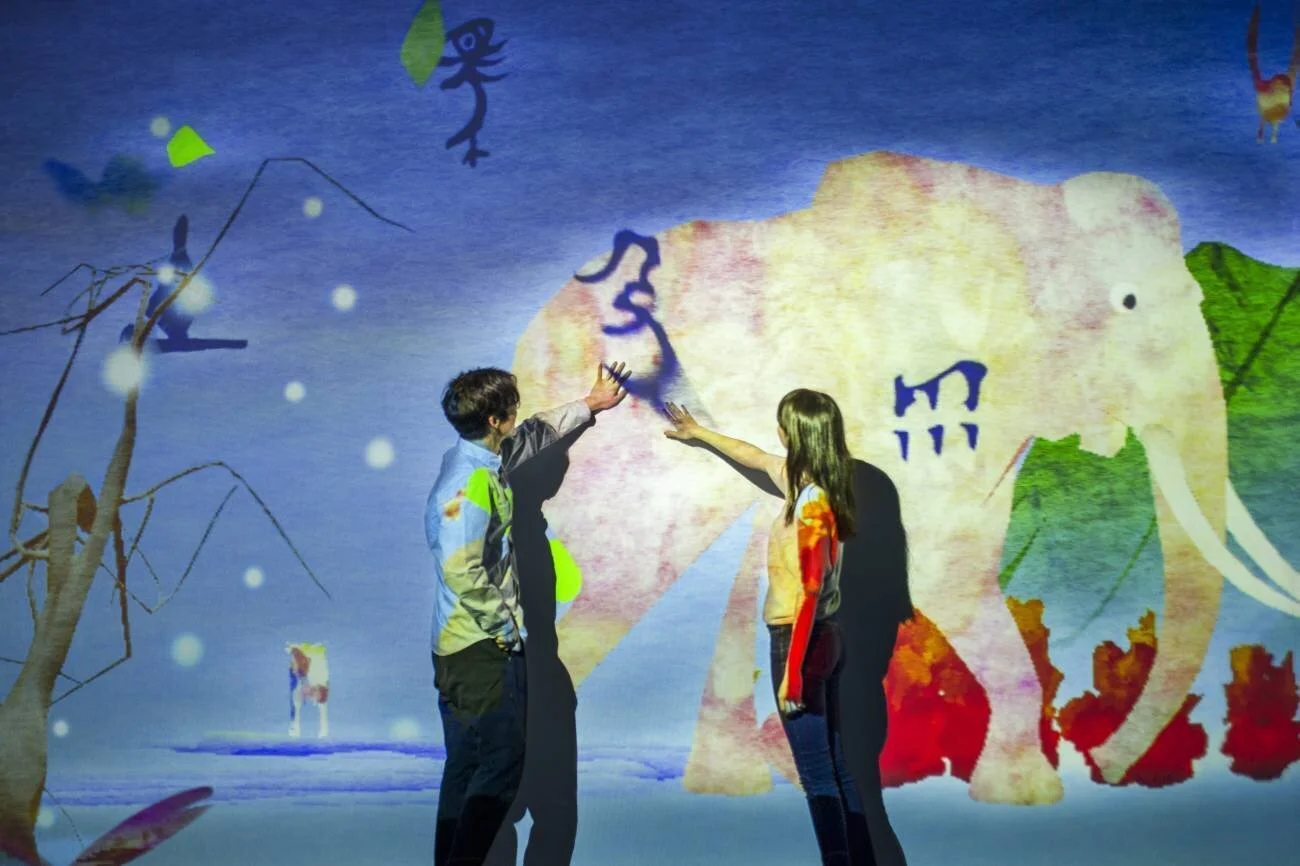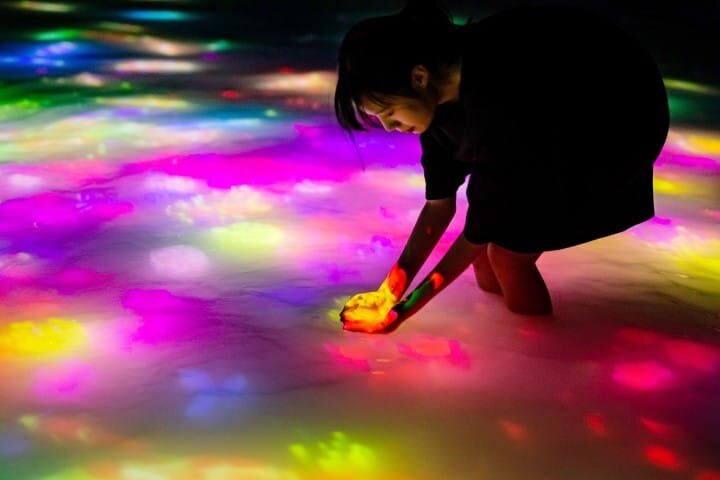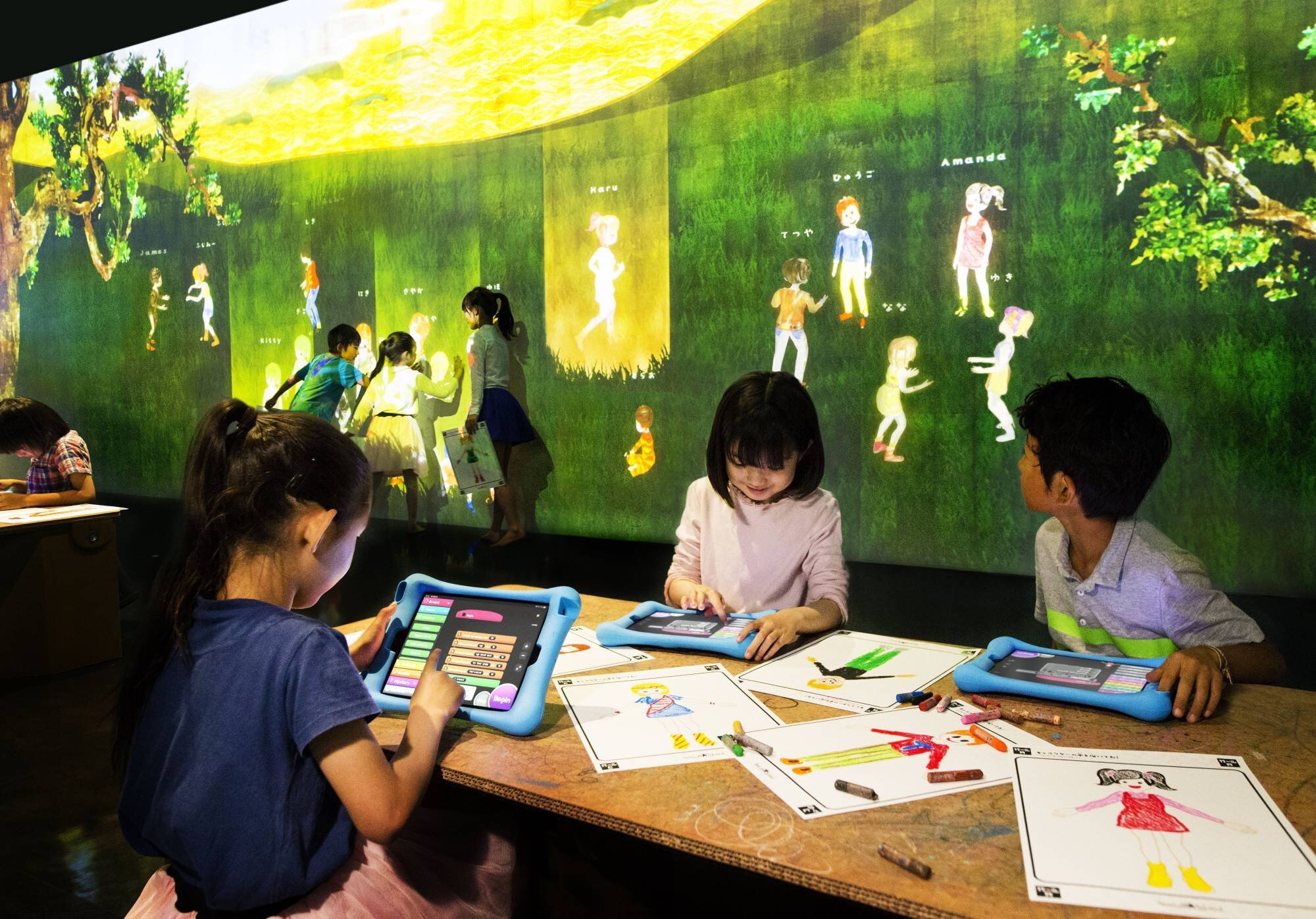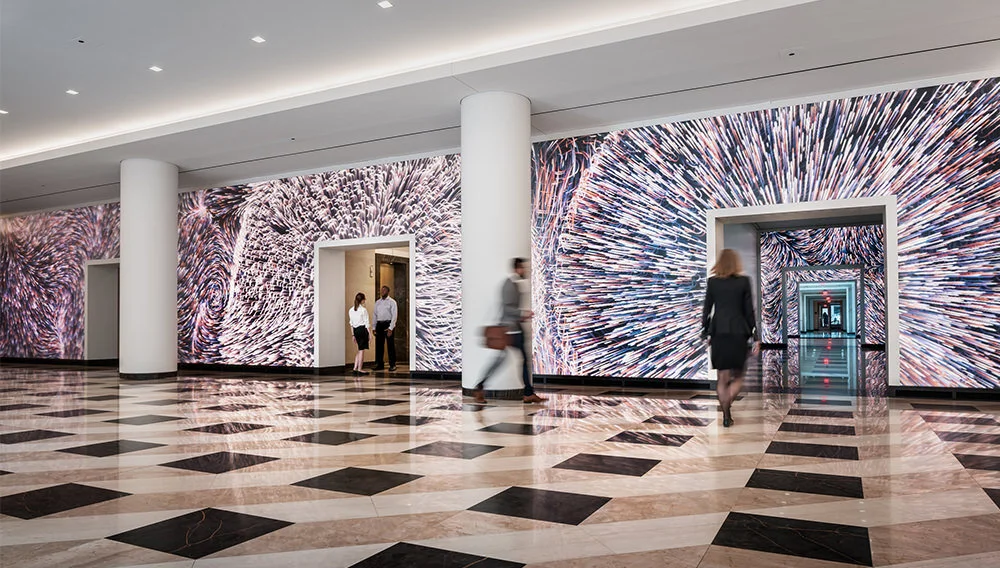Written By Hanmo Zhou
Introduction
The concept of interactivity in visual arts became popular in the 1950s with the realization that interactive art could serve as a bridge connecting artists and audiences in new ways. More importantly, audiences were able to become part of the artwork through their experience within the artistic process. The application of traditional interactive concepts today is often seen as conventional within galleries, yet remains unconventional when presented in public, such as on streets and in abandoned buildings. Collaboration between art and science furthered opportunities with the rise of digital interactive art in the 1970s.
It is crucial to identify the links between the terms “digital” and “interactive” when discussing digital interactive art. According to the Tate Museum, digital art includes artworks that are either made using technology or shown in a digital format. Interactive art relies on audience participation. Thus, digital interactive installations showcase and activate a large physical space accompanied by mixed-media compositions, engaging viewers with responsive technology. However, while the marriage of these two terms is necessary to acknowledge, it is important to note that digital art and interactive art are independent artforms. Not all interactive art must be digital art, and not all digital art is interactive.
Today, many artists have discovered technology as a new medium not only to create art, but to transform traditional artworks into innovative, immersive events. Artists have long explored the use of technology in their craft, such as the utilization of lasers and video projection, in order to improve the quality of audiences' interactive experiences. The emergence of new artistic mediums has reshaped the arts industry by generating new forms of artistic creation, appreciation, consumption, as well as education. Therefore, digital interactive art and installations are on the increase in arts enterprises.
Different Approaches & Examples
Since the term interactive could be interpreted differently in various fields, there are several categorizations in approaching it. Before discussing the different categories of digital interactive artworks, it is essential to recognize the four components that make a work a form of digital art installation: artwork, audience, artist, and environment. There are several relationships between these components that occur during the process of installation.
Interactions in a Digital Art installation. Source: Research Gate
In addition to the four components of digital art installations, there are four categories in which these artworks can be placed: static, dynamic passive, dynamic interactive, and dynamic interactive (varying). The category static describes works wherein the art object is mostly static and does not adapt itself to the context. In other words, there is no interaction between the audience and the artwork. Dynamic passive describes when the artwork remains inactive in response to audience interaction, but changes with time. In dynamic interactive artwork, audiences play an active role and are given the ability to change the artwork when interacting with it. Dynamic interactive (varying), is the same conceptual realm of dynamic interactive artwork, except that each iteration of the art is unpredictable because it is continually influenced by the accumulation of user interaction. Examples of dynamic interactive and dynamic interactive (varying) artwork are demonstrated below.
Installation view of teamLab Borderless. Source: teamLab
TeamLab, founded in 2001, is a Japan-based "collaborative, interdisciplinary creative group that brings together professionals from various fields of practice in the digital society: artists, programmers, engineers, CG animators, mathematicians, architects, web and print graphic designers, and editors." TeamLab uses Epson's 3LCD projectors to project immersive digital installations, referring to itself as an "ultra-technologist" as it aims to connect and reach an equilibrium between art, science, technology, creativity, and the natural world. This is because technology expands art and therefore digital art fosters new relationships between people.
Story of the Time when Gods were Everywhere. Source: teamLab
TeamLab's interactive installation Story of the Times When Gods Were Everywhere is an example of art categorized as dynamic interactive (varying) because the intention of the project builds upon the viewers' collaboration skills. In this digital interactive installation, audiences touch the wall, launching characters to the installation. As a result, teamLab enhances audience interaction and shared emotional connection to the work. Furthermore, this project connects the audiences to the external environment, rather than just appreciating the artwork by itself.
teamLab Planets Tokyo. Source: Matcha
Installation view of FLUIDIC. Source: Digital Meets Culture
FLUIDIC – “Sculpture in Motion,” displayed in the Temporary Museum of New Design in Milan and designed and developed by WHITEvoid for Hyundai, is an example of a dynamic interactive artwork. The installation uses powerful laser projectors that form a "seemingly floating-point cloud above a water pond … consisting of 12,000 translucent spheres…. Due to a complex computer algorithm the spheres are arranged seemingly random within the cloud. At the same time the algorithm observes the positions and projection angles of eight high-speed laser projectors that are being arranged around the artwork." Molecules move constantly as they are shaped by the audience interactions, both intentionally and unintentionally – the artwork is the constant interaction with audience members. This interaction is made possible through a 3D camera tracking system to detects of the audiences’ position, posture, and movement, enabling its precise, interactive response. The purpose of this installation is to translate Hyundai's design philosophy into a live and emerging imaginative art experience that was designed to not only entertain the public, but to better connect with them.
FLUIDIC Installation. Source: WHITEvoid
Influence on arts industries
Digital interactive installations have garnered a great deal of attention from arts enterprises and has reshaped the industry in many ways. This art form has transformed the way that art is made, distributed, engaged with, consumed, and taught.
The rise of the digital age began between the 1950s and 1970s, marking the period where artists, engineers, and scientists began to work in tandem to create and install tech-drive arts exhibits. Since then, artists have sought unconventional tools to express their artistic principles, often leading them to explore and embrace technology as a new medium. The rise of digital art has created a path for artists to promote their work to broader audiences because it can be exhibited globally, eliminating the need for transportation and travel.
Digital Interactive Installations have a significant impact on audiences. Digital art makes art more accessible to new audiences — offering experiences that allow almost anyone to participate. These experiences also have a deeper impact on audiences through allowing personalized expression and the creation of memorable, poetic, and immersive experiences. When audiences no longer worry about damaging a piece of art through interaction (such as touch), the connection to the product is significantly deepened. Additionally, the point of this art, the interactivity and its subsequent artistic results, reflects the audience’s social reality and the current age of information and technology.
Not only has digital art altered the audience’s experience, it has changed the way that art is consumed. For example the introduction of NFTs has shown evidence in fueling the development of digital arts, as creators work on establishing a secure system for collectors to acquire art. NFTs also makes art collection more accessible and convenient, since buying virtual tokens is easier than buying a physical piece of art.
Play! Programming for Geniuses. Source: teamLab
Furthermore, digital interactive technology serves as a tool and point of interest that promotes arts education in younger generations. TeamLab pioneered Future Park, a program that seeks to change the relationships between installation viewers, foster collaboration between audiences, and make the presence of others a more positive experience.
Concerns
A major concern with the rise of digital and digital interactive art is its validity as “real art.” This argument derives from the fact that the work is often computer-generated or driven, thus creating a difficulty in detecting the originality and uniqueness of an artwork. This concern poses a question of the public assumption of art, and if the continual innovation and integration of technology in art will redefine what defines art, or at least how digital art is classified.
Another concern of digital art is its preservation and conservation. This concern specifically addresses the risk of losing digital assets caused by computer virus attacks or hard drive damage. Though digital assets management systems (DAMS) exist to protect digital assets, purchasing a comprehensive digital preservation program is expensive, and also requires time and manpower to implement and maintain.
Future Opportunities
The growth of technology has played a critical role in reshaping society, connection to the outside world, and perceptions of others. The increase of digital arts installations in cities is impacting how people engage with public spaces. Most importantly, digital art has endless potential and is likely to become a more desired preference in the future, providing an avenue for digital art installations to have greater possibilities for interactivity.
Responsive Art in the Working Environment. Source: Esidesign
Education
Using digital interactive installations is an excellent tactic that draws attention and interest to viewers, making a potentially effective way of promoting arts in the classroom. The integration of digital interactive installations can aid in providing more equitable accessibility of art and improve the effectiveness of educational outcomes, such as collaboration skills and critical and creative thinking.
Realism
I Felt A Headshot In VR With This Haptic Feedback Kit. Source: YouTube
Audiences are unable to interact with digital art as they are able to with physical art. Many companies have been developing the design of haptic suits, which implements the use of vibration in order to convey another layer of information to audiences and improving user experience to achieve a higher level of interactive engagement. With the optimization and development of touch sensor technology, a more immersive and realistic feeling of digital interactive installations is likely to be achieved in the future.
Wider Public Engagement
A new opportunity for art consumption is the wide range of applications of NFTs. During the pandemic, people spent more time overall on the internet and online shopping, which opened the door for NFT discovery. NFTs have produced a new path and platform for art enthusiasts and arts managers to utilize.
Conclusion
Digital art has been the catalyst of fresh creativity in the artistic realm, attracting broader audiences and encouraging them to become enthusiastic and engaged in the world of art. Artists in the field develop innovative artworks exploring the boundaries of art itself. These advances offer greater accessibility in individuals’ artistic experiences. Moreover, the physical return to museums and galleries post-covid enhances digital interactive installations since audiences can experience this art live in a physical space, fostering a new sense of curiosity and community. The more frequent implementation of digital interactive installations in the technological age is just the beginning of its artistic evolution.
+ Resources
“About Future Park.” teamLab Learn and Play! Future Park. Accessed May 10, 2021. https://futurepark.teamlab.art/en/about/.
“About TeamLab.” Digital meets Culture. Accessed May 10, 2021. https://www.digitalmeetsculture.net/article/teamlab-tokyo-based-digital-artist-collaborati ve/.
Ahmed, Salah Uddin. “Interaction and Interactivity: In the Context of Digital Interactive Art Installation.” Research Gate, January 2018.
Ambalina, Limarc. “Are Haptic Suits the Future of VR?” Medium. SUPER JUMP, August 10,
Cascone, Sarah. “Andy Warhol's Lost Digital Art Rescued.” Artnet News. February 15, 2017. https://news.artnet.com/art-world/cory-arcangel-excavates-andy-warhols-digital-art-fromancient-floppy-disks-11819.
“Digital Art – Art Term.” Tate. Accessed May 10, 2021. https://www.tate.org.uk/art/art-terms/d/digital-art.
“Digital Art Movement Overview.” The Art Story. Accessed May 10, 2021. https://www.theartstory.org/movement/digital-art/.
“Discover What Makes Art Installations Interactive and What Is the Effect of It.” Installation Art, April 29, 2021. https://installationart.tv/interactive-art/.
Edmonds, E., Turner, G., & Candy, L. "Approaches to interactive art systems." 2004.
“FLUIDIC – Sculpture in Motion.” Digital meets Culture. Accessed May 10, 2021. https://www.digitalmeetsculture.net/article/fluidic-sculpture-in-motion/.
H, Alison. “Digital Art - A Revolutionary Form of Art.” FeltMagnet. FeltMagnet, July 12, 2017. https://feltmagnet.com/drawing/Digital-Art-A-Revolutionary-Form-of-Art.
Holland, Oscar. “How NFTs Are Fueling a Digital Art Boom.” CNN. Cable News Network, March 10, 2021. https://edition.cnn.com/style/article/nft-digital-art-boom/index.html.
“How Digital Installations Shape the Future of Public Art.” IBI Group, August 16, 2017. https://www.ibigroup.com/ibi-insights/digital-installations-future-public-art/.
“How Technology Is Changing the Art World.” ARTDEX, July 31, 2020. https://www.artdex.com/how-technology-is-changing-the-art-world-2/.
“Installation Art – Art Term.” Tate. Accessed May 10, 2021. https://www.tate.org.uk/art/art-terms/i/installation-art.
“Interactive Art – Art Term.” Tate. Accessed May 10, 2021. https://www.tate.org.uk/art/art-terms/i/interactive-art.
Levine, Irene S. “New Subterranean Digital Art Installation Opens In NYC.” Forbes. Forbes Magazine, February 7, 2020. https://www.forbes.com/sites/irenelevine/2020/02/07/new-subterranean-digital-art-installation-opens-in-nyc/?sh=e5da9a567ed3.
Lombardo, Giorgia. “A World Without Boundaries: Interview With TeamLab.” Medium. DeMagSign, March 31, 2020. https://medium.com/demagsign/a-world-without-boundaries-interview-with-teamlab-2bbf91b91956.
Low, Jyue Tyan. “A Practical Documentation Practice for the Management and Preservation of Digital Video/ Media and Installation Art.” Heritage Conservation Centre, 2012. http://cidoc.mini.icom.museum/wpcontent/uploads/sites/6/2018/12/low-.pdf.
“Our Guide to Interactive Installations.” Mbryonic, November 22, 2019. https://mbryonic.com/installations-guide/.
Ruggiero, Lucia. “'Rain Room' at London's Barbican.” Digital meets Culture, November 7, 2012. https://www.digitalmeetsculture.net/article/rain-room-at-londons-barbican/.
Steinwold, Andrew. “The Future Of Art: Why Digital Art Is Better Than Physical Art.” ZimaRed, October 30, 2019. https://andrewsteinwold.substack.com/p/the-future-of-art-why-digital-art.
Sweeney, Sabrina. “Exhibition Gives Visitors Power to Control the Rain.” BBC News. BBC, October 4, 2012. https://www.bbc.com/news/entertainment-arts-19827066.
“THE FUTURE OF ART: DIGITAL INSTALLATIONS AND...: ETEM Leading Aluminium Extrusion Company,” August 24, 2020. https://www.etem.com/blog/the-future-of-art-digital-installations-and-interactive-spaces.
Webster, Emily. “3 Types of Digital Art Installations For Your Office Lobby.” ESI Design,January 21, 2021. https://esidesign.com/3-types-of-digital-installation-art-for-your-office-lobby/.
“World Leading Projector Manufacturer Epson Chosen to Provide Contemporary New Museum in Finland with Immersive Art Experience from Japanese Art Collective TeamLab.”Epson, January 10, 2018. https://www.epson.eu/insights/article/world-leading-projector-manufacturer-epson-chosen-to-provide-contemporary-new-museum-in-finland-with-immersive-art-experience-from-japanese-art-collective-teamlab.

